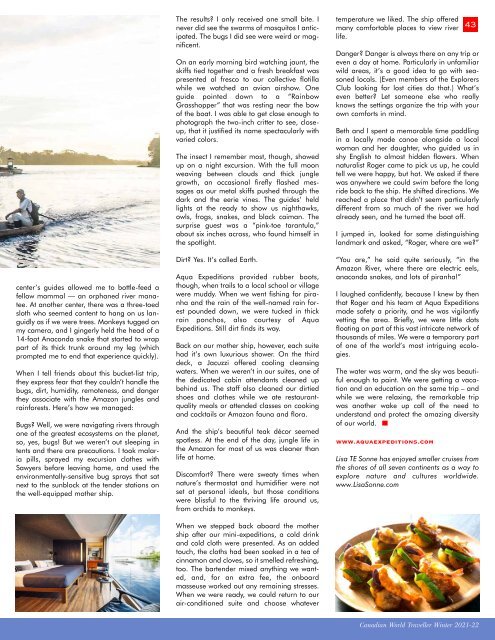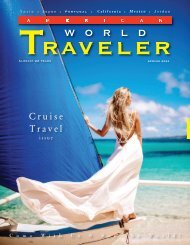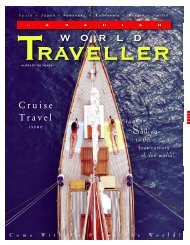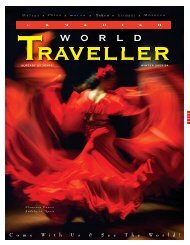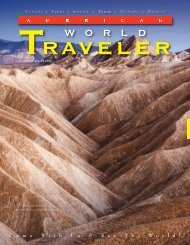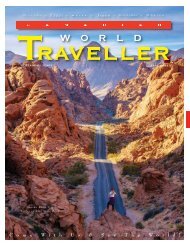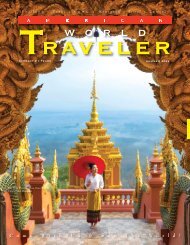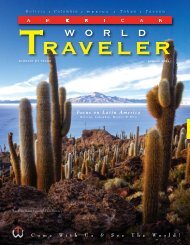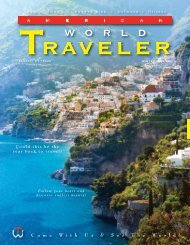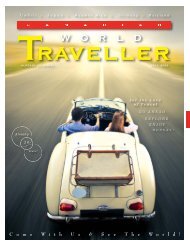Canadian World Traveller Winter 2021-22 Issue
Now in our 20th year of publishing, Canadian World Traveller explores the culture and history of worldwide destinations, sharing the adventure of discovery with our readers and motivating them to make their travel dreams a reality. Published quarterly, CWT helps sophisticated, independent Canadian travellers choose their next destination by offering a lively blend of intelligent, informative articles and tantalizing photographic images from our World’s best destinations, cruises, accommodations and activities to suit every traveller's taste.
Now in our 20th year of publishing, Canadian World Traveller explores the culture and history of worldwide destinations, sharing the adventure of discovery with our readers and motivating them to make their travel dreams a reality. Published quarterly, CWT helps sophisticated, independent Canadian travellers choose their next destination by offering a lively blend of intelligent, informative articles and tantalizing photographic images from our World’s best destinations, cruises, accommodations and activities to suit every traveller's taste.
You also want an ePaper? Increase the reach of your titles
YUMPU automatically turns print PDFs into web optimized ePapers that Google loves.
center’s guides allowed me to bottle-feed a<br />
fellow mammal — an orphaned river manatee.<br />
At another center, there was a three-toed<br />
sloth who seemed content to hang on us languidly<br />
as if we were trees. Monkeys tugged on<br />
my camera, and I gingerly held the head of a<br />
14-foot Anaconda snake that started to wrap<br />
part of its thick trunk around my leg (which<br />
prompted me to end that experience quickly).<br />
When I tell friends about this bucket-list trip,<br />
they express fear that they couldn’t handle the<br />
bugs, dirt, humidity, remoteness, and danger<br />
they associate with the Amazon jungles and<br />
rainforests. Here’s how we managed:<br />
Bugs? Well, we were navigating rivers through<br />
one of the greatest ecosystems on the planet,<br />
so, yes, bugs! But we weren’t out sleeping in<br />
tents and there are precautions. I took malaria<br />
pills, sprayed my excursion clothes with<br />
Sawyers before leaving home, and used the<br />
environmentally-sensitive bug sprays that sat<br />
next to the sunblock at the tender stations on<br />
the well-equipped mother ship.<br />
The results? I only received one small bite. I<br />
never did see the swarms of mosquitos I anticipated.<br />
The bugs I did see were weird or magnificent.<br />
On an early morning bird watching jaunt, the<br />
skiffs tied together and a fresh breakfast was<br />
presented al fresco to our collective flotilla<br />
while we watched an avian airshow. One<br />
guide pointed down to a “Rainbow<br />
Grasshopper” that was resting near the bow<br />
of the boat. I was able to get close enough to<br />
photograph the two-inch critter to see, closeup,<br />
that it justified its name spectacularly with<br />
varied colors.<br />
The insect I remember most, though, showed<br />
up on a night excursion. With the full moon<br />
weaving between clouds and thick jungle<br />
growth, an occasional firefly flashed messages<br />
as our metal skiffs pushed through the<br />
dark and the eerie vines. The guides’ held<br />
lights at the ready to show us nighthawks,<br />
owls, frogs, snakes, and black caiman. The<br />
surprise guest was a “pink-toe tarantula,”<br />
about six inches across, who found himself in<br />
the spotlight.<br />
Dirt? Yes. It’s called Earth.<br />
Aqua Expeditions provided rubber boots,<br />
though, when trails to a local school or village<br />
were muddy. When we went fishing for piranha<br />
and the rain of the well-named rain forest<br />
pounded down, we were tucked in thick<br />
rain ponchos, also courtesy of Aqua<br />
Expeditions. Still dirt finds its way.<br />
Back on our mother ship, however, each suite<br />
had it’s own luxurious shower. On the third<br />
deck, a Jacuzzi offered cooling cleansing<br />
waters. When we weren’t in our suites, one of<br />
the dedicated cabin attendants cleaned up<br />
behind us. The staff also cleaned our dirtied<br />
shoes and clothes while we ate restaurantquality<br />
meals or attended classes on cooking<br />
and cocktails or Amazon fauna and flora.<br />
And the ship’s beautiful teak décor seemed<br />
spotless. At the end of the day, jungle life in<br />
the Amazon for most of us was cleaner than<br />
life at home.<br />
Discomfort? There were sweaty times when<br />
nature’s thermostat and humidifier were not<br />
set at personal ideals, but those conditions<br />
were blissful to the thriving life around us,<br />
from orchids to monkeys.<br />
When we stepped back aboard the mother<br />
ship after our mini-expeditions, a cold drink<br />
and cold cloth were presented. As an added<br />
touch, the cloths had been soaked in a tea of<br />
cinnamon and cloves, so it smelled refreshing,<br />
too. The bartender mixed anything we wanted,<br />
and, for an extra fee, the onboard<br />
masseuse worked out any remaining stresses.<br />
When we were ready, we could return to our<br />
air-conditioned suite and choose whatever<br />
temperature we liked. The ship offered<br />
many comfortable places to view river<br />
life.<br />
Danger? Danger is always there on any trip or<br />
even a day at home. Particularly in unfamiliar<br />
wild areas, it’s a good idea to go with seasoned<br />
locals. (Even members of the Explorers<br />
Club looking for lost cities do that.) What’s<br />
even better? Let someone else who really<br />
knows the settings organize the trip with your<br />
own comforts in mind.<br />
Beth and I spent a memorable time paddling<br />
in a locally made canoe alongside a local<br />
woman and her daughter, who guided us in<br />
shy English to almost hidden flowers. When<br />
naturalist Roger came to pick us up, he could<br />
tell we were happy, but hot. We asked if there<br />
was anywhere we could swim before the long<br />
ride back to the ship. He shifted directions. We<br />
reached a place that didn’t seem particularly<br />
different from so much of the river we had<br />
already seen, and he turned the boat off.<br />
I jumped in, looked for some distinguishing<br />
landmark and asked, “Roger, where are we?”<br />
“You are,” he said quite seriously, “in the<br />
Amazon River, where there are electric eels,<br />
anaconda snakes, and lots of piranha!”<br />
I laughed confidently, because I knew by then<br />
that Roger and his team at Aqua Expeditions<br />
made safety a priority, and he was vigilantly<br />
vetting the area. Briefly, we were little dots<br />
floating on part of this vast intricate network of<br />
thousands of miles. We were a temporary part<br />
of one of the world’s most intriguing ecologies.<br />
The water was warm, and the sky was beautiful<br />
enough to paint. We were getting a vacation<br />
and an education on the same trip – and<br />
while we were relaxing, the remarkable trip<br />
was another wake up call of the need to<br />
understand and protect the amazing diversity<br />
of our world.<br />
www.aquaexpeditions.com<br />
43<br />
Lisa TE Sonne has enjoyed smaller cruises from<br />
the shores of all seven continents as a way to<br />
explore nature and cultures worldwide.<br />
www.LisaSonne.com<br />
<strong>Canadian</strong> <strong>World</strong> <strong>Traveller</strong> <strong>Winter</strong> <strong>2021</strong>-<strong>22</strong>


